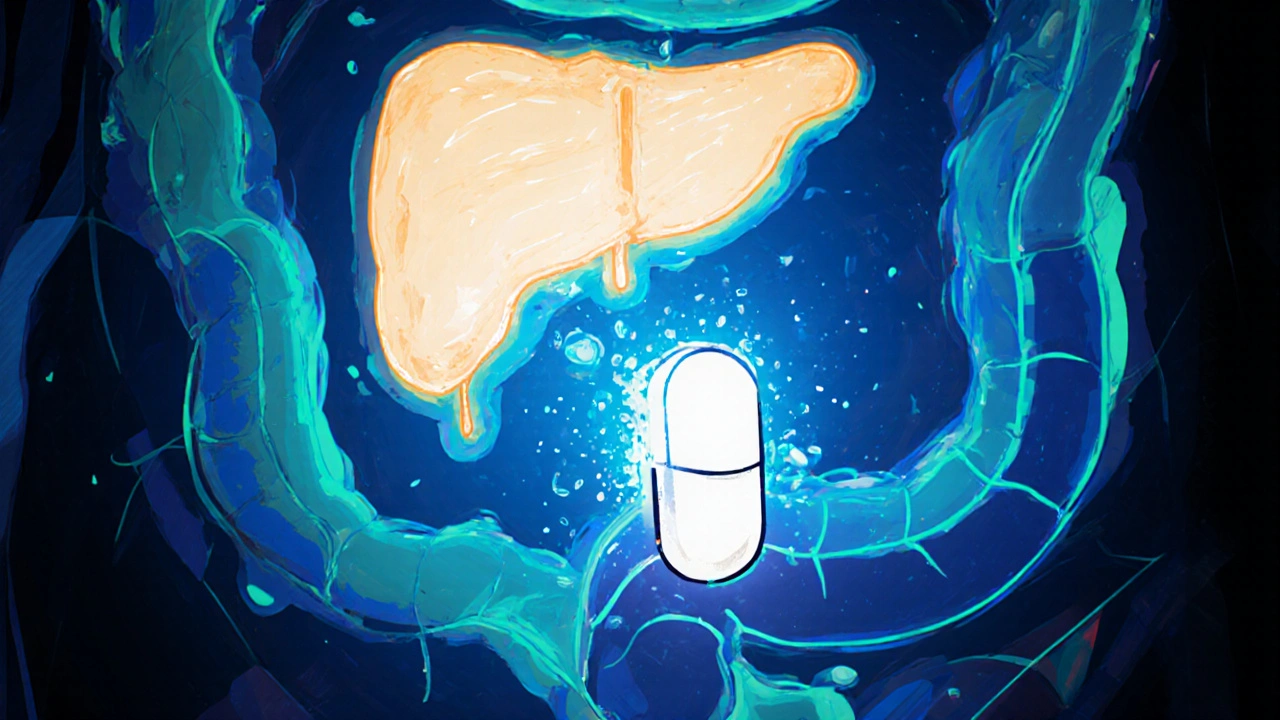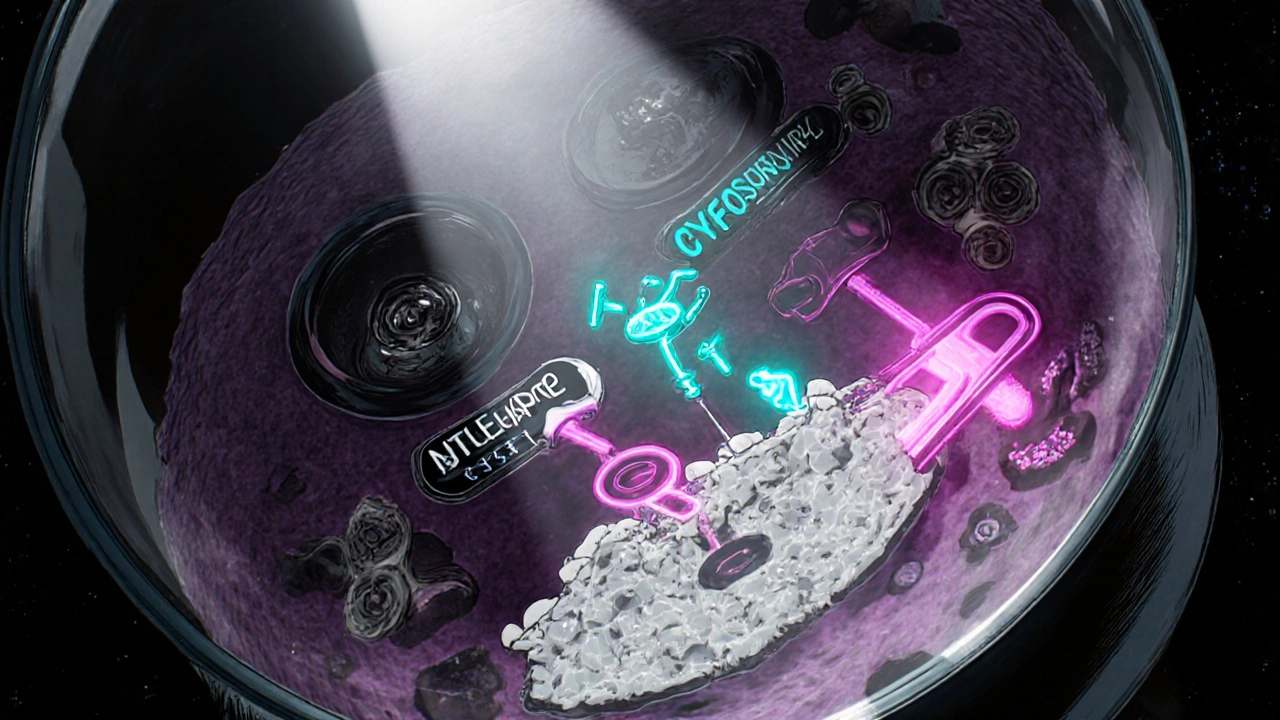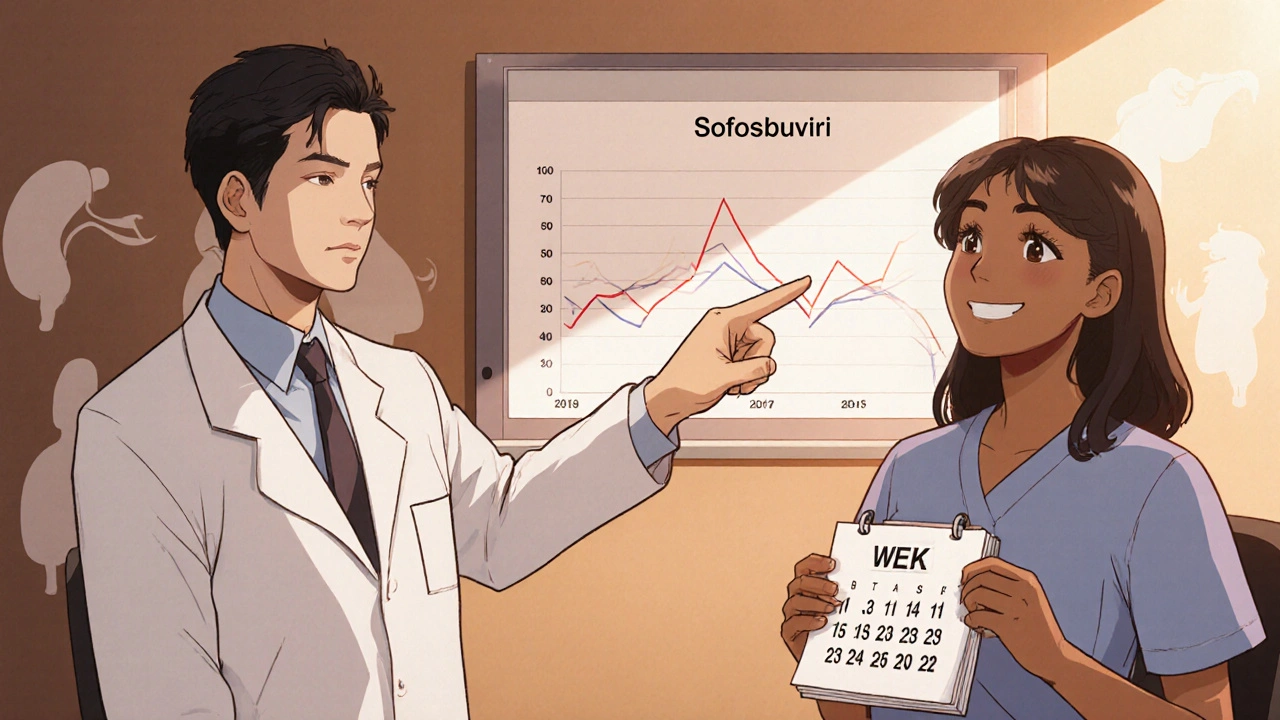Sofosbuvir Pharmacokinetics in Hepatitis C Treatment: A Complete Guide
 Oct, 19 2025
Oct, 19 2025
Sofosbuvir Half-Life Calculator
How Half-Life Works
The article states that sofosbuvir's active metabolite GS-331007 has a terminal half-life of approximately 27 hours. Every 27 hours, the concentration of the drug in your body decreases by 50%. This calculator shows how much of the drug remains after multiple half-lives.
Results will appear here after calculation
Key Takeaways
- Sofosbuvir is a prodrug that becomes the active metabolite GS‑331007 after liver activation.
- Absorption is rapid with a ~90% bio‑availability; food does not affect exposure.
- It distributes widely, showing low plasma protein binding (~61%) and high intracellular concentrations.
- Metabolism relies on intracellular kinases, not cytochrome P450, making drug-drug interactions limited.
- Elimination is mainly renal (78% of dose) with a terminal half‑life of ~27 hours for GS‑331007.
Sofosbuvir is a nucleotide‑analog prodrug that blocks the hepatitis C virus (HCV) NS5B RNA‑dependent RNA polymerase. When taken with other direct‑acting antivirals, it forms the backbone of most modern Hepatitis C Virus infection regimens, delivering cure rates above 95% in most genotypes.
What Is Sofosbuvir and How Does It Work?
In the liver, cellular enzymes convert sofosbuvir into its pharmacologically active triphosphate form. This metabolite mimics the natural nucleoside uridine and gets incorporated into the viral RNA chain, causing premature termination. The target is the viral NS5B polymerase the enzyme responsible for replicating HCV RNA. Because the drug acts inside infected cells, its concentration at the site of replication is a more meaningful measure than plasma levels.
Absorption and Bioavailability
After oral administration, sofosbuvir reaches peak plasma concentrations (Cmax) in 0.5-2 hours. Studies in healthy volunteers show a mean Cmax of about 2,200 ng/mL after a 400 mg dose, translating to roughly 90% oral bioavailability. Food does not change the area under the curve (AUC), so the drug can be taken with or without meals-a convenience that improves adherence.
Distribution: Where Does the Drug Go?
Only about 61% of sofosbuvir binds to plasma proteins, leaving a sizable free fraction to cross cell membranes. The drug distributes well into the liver and peripheral tissues, achieving intracellular concentrations that are 10‑fold higher than plasma. The high hepatic uptake is driven by the organic anion transporting polypeptide (OATP) family, especially OATP1B1 and OATP1B3. Because the liver is the site of HCV replication, this distribution profile is ideal.

Metabolism: From Prodrug to Active Triphosphate
Sofosbuvir is a phosphoramidate prodrug. Within hepatocytes, three key steps occur:
- Carboxylesterase‑1 (CES1) removes the ethyl ester.
- Histidine triad nucleotide‑binding protein 1 (HINT1) cleaves the phosphate‑aryl bond.
- A series of phosphorylation steps by nucleoside kinases produces the pharmacologically active GS‑331007‑triphosphate.
The primary circulating metabolite, GS‑331007, is inactive but serves as a pharmacokinetic marker because it mirrors the exposure of the active triphosphate. Importantly, the pathway bypasses cytochrome P450 enzymes, which explains the low incidence of metabolic drug interactions.
Elimination: How the Body Gets Rid of Sofosbuvir
After the prodrug converts to GS‑331007, renal excretion dominates. Approximately 78% of an administered dose appears unchanged in the urine within 24 hours. The terminal half‑life of the metabolite is about 27 hours, allowing once‑daily dosing. A small fraction (≈14%) is eliminated via feces, reflecting biliary secretion. Because the active intracellular triphosphate has a short intracellular half‑life (<12 hours), steady‑state concentrations are reached within 2-3 days of therapy.
Special Populations: Adjusting the Picture
While the standard 400 mg once‑daily regimen works for most adults, certain groups need extra attention.
- Renal impairment: In patients with eGFR < 30 mL/min/1.73 m², the AUC of GS‑331007 can increase up to 4‑fold. Current guidelines advise a reduced dose of 400 mg every other day or, in many cases, avoidance of sofosbuvir‑containing regimens.
- Hepatic impairment: Mild (Child‑Pugh A) and moderate (Child‑Pugh B) liver disease do not significantly change exposure, so no dose adjustment is needed. Severe disease (Child‑Pugh C) has limited data; clinicians often consider alternative regimens.
- Pregnancy: Animal studies show no teratogenicity, but human data are limited. Sofosbuvir is generally avoided unless the benefit outweighs risk.
- Pediatrics (≥3 years, ≥17 kg): The same 400 mg daily dose is approved, showing similar PK parameters to adults.

Drug-Drug Interactions: What to Watch For
Because sofosbuvir does not use the CYP450 system, most classic enzyme‑based interactions are absent. However, transporters matter.
- P‑glycoprotein (P‑gp) inhibitors (e.g., rifampin, carbamazepine) can lower sofosbuvir exposure. Concomitant use is discouraged.
- NS5A inhibitors such as ledipasvir, daclatasvir, or velpatasvir are often co‑administered. Their PK profiles are complementary, and fixed‑dose combinations have been extensively studied.
- Ribavirin, when added for certain genotypes, does not affect sofosbuvir PK but adds hematologic monitoring requirements.
Clinical Implications: Dosing, Monitoring, and Efficacy
The pharmacokinetic properties of sofosbuvir enable a simple once‑daily regimen, which translates into high adherence rates. Therapeutic drug monitoring is rarely needed; instead, clinicians focus on viral load testing at baseline, week 4, and week 12 (or week 24 for cirrhotic patients) to confirm sustained virologic response (SVR).
Because exposure is consistent across most demographics, the drug delivers cure rates of 95‑99% when paired with an appropriate NS5A inhibitor, regardless of genotype 1‑4. The predictable PK profile also supports use in real‑world settings, including community clinics and correctional facilities.
Comparative Pharmacokinetics of Common Direct‑Acting Antivirals
| Parameter | Sofosbuvir | Ledipasvir | Velpatasvir |
|---|---|---|---|
| Mechanism | Nucleotide polymerase inhibitor | NS5A inhibitor | NS5A inhibitor |
| Bioavailability | ~90% | ~76% | ~85% |
| Protein Binding | 61% | 99.8% | 99.7% |
| Renal Excretion | 78% (GS‑331007) | Negligible | Negligible |
| Half‑Life | ~27 h (GS‑331007) | ~47 h | ~55 h |
The table illustrates why sofosbuvir requires dose adjustment in renal failure, while NS5A inhibitors are largely unaffected. This distinction guides regimen selection for patients with compromised kidneys.
Frequently Asked Questions
Does food affect the absorption of sofosbuvir?
No. Clinical trials showed identical AUC values when taken with a high‑fat meal versus fasting, so you can take it at any time that fits your schedule.
Can I use sofosbuvir if I have mild kidney disease?
Yes. For eGFR ≥ 30 mL/min, the standard 400 mg daily dose is safe. Below that threshold, dose reduction or an alternative regimen is recommended.
What is the role of the metabolite GS‑331007?
GS‑331007 is the primary circulating metabolite. It is inactive but serves as a reliable marker for drug exposure because its levels reflect the intracellular formation of the active triphosphate.
Do proton‑pump inhibitors interfere with sofosbuvir?
No. Since sofosbuvir absorption is not pH‑dependent, PPIs have no meaningful impact.
Is therapeutic drug monitoring required for sofosbuvir?
Generally not. The drug’s PK is predictable, and viral load testing is the standard way to gauge treatment success.
Understanding the pharmacokinetics of sofosbuvir lets clinicians match the right regimen to each patient’s profile, ensuring the highest chance of cure with the fewest complications. When the drug’s absorption, distribution, metabolism, and elimination are clear, the rest of the treatment journey becomes a lot smoother.
Christopher Burczyk
October 19, 2025 AT 20:52Sofosbuvir’s pharmacokinetic profile is a textbook example of a well‑engineered antiviral prodrug, and any deviation from the parameters outlined in this guide would be considered sub‑optimal. The drug achieves near‑complete oral bioavailability, hovering around 90%, which is remarkable for a nucleotide analog. Peak plasma concentrations are reached within 30 minutes to two hours, providing rapid systemic exposure. Despite its modest plasma protein binding of approximately 61%, the free fraction is sufficient to cross cellular membranes and accumulate in hepatocytes. The hepatic uptake is facilitated primarily by OATP1B1 and OATP1B3 transporters, ensuring that the prodrug reaches its site of action efficiently. Intracellular conversion involves a three‑step cascade: CES1‑mediated ester hydrolysis, HINT1‑catalyzed phosphoramidate cleavage, and successive phosphorylation by nucleoside kinases to generate the active triphosphate. The subsequent formation of the inactive metabolite GS‑331007 serves as a reliable pharmacokinetic marker because its plasma concentrations mirror the exposure of the active moiety. Renal excretion dominates the elimination pathway, with roughly 78% of the administered dose recovered unchanged in the urine within a 24‑hour window. The terminal half‑life of GS‑331007 approximates 27 hours, supporting once‑daily dosing regimens that enhance patient adherence. Importantly, the metabolic pathway bypasses cytochrome P450 enzymes, resulting in a low propensity for drug‑drug interactions, a crucial consideration for patients on polypharmacy. The residual 14% of the dose eliminated via feces reflects biliary secretion, which is not clinically significant but worth noting for completeness. In clinical practice, these pharmacokinetic attributes translate into cure rates exceeding 95% across most HCV genotypes when used in combination regimens. The safety profile is further bolstered by the limited systemic exposure to the active triphosphate, reducing the risk of off‑target effects. Overall, the interplay of rapid absorption, targeted hepatic distribution, and efficient renal clearance makes sofosbuvir a paradigm of modern antiviral design. Any therapeutic protocol that neglects these pharmacokinetic nuances risks compromising efficacy and safety.
Bobby Marie
October 31, 2025 AT 10:38The guide nails the key points but could use a clearer table for the metabolic steps. Also, a quick note on dosage adjustments for renal impairment would be helpful.
Overall, solid summary.
Christian Georg
November 12, 2025 AT 00:25Great rundown! I love how the article breaks down the intracellular conversion – it really demystifies why the drug is so effective 😊.
For clinicians, remembering that food doesn’t affect exposure can simplify counseling. Keep it up!
parth gajjar
November 23, 2025 AT 14:12Honestly this is the most elegant piece on sofosbuvir I’ve read the drug’s journey from prodrug to active form feels almost poetic its pharmacokinetics read like a symphony of processes without the usual noisy jargon
Maridel Frey
December 5, 2025 AT 03:58The inclusion of both the active triphosphate and the circulating metabolite GS‑331007 provides a comprehensive view that benefits both clinicians and pharmacists. By emphasizing the minimal cytochrome P450 involvement, the article highlights an important safety advantage for patients on multiple therapies.